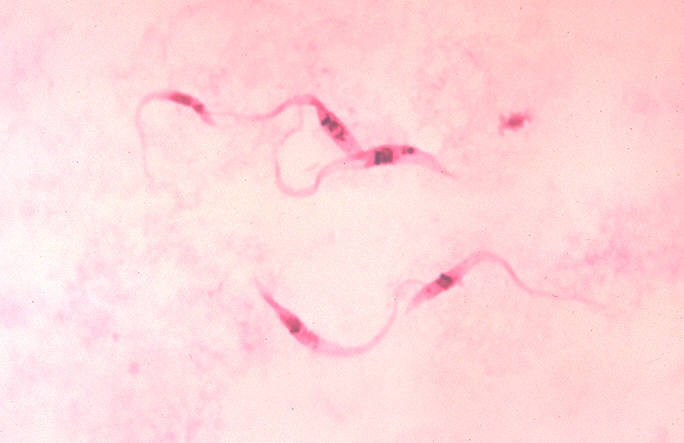- Trypanosome
Taxobox
color = khaki
name = Trypanosomes

image_width = 300px
image_caption = "Trypanosoma cruzi " parasites
domain = Eukaryota
unranked_phylum =Excavata
phylum =Euglenozoa
subphylum =Mastigophora
classis = Kinetoplastea
ordo = Trypanosomatida
subdivision_ranks = Genera
subdivision = "Blastocrithidia " "Crithidia " "Endotrypanum " "Herpetomonas " "Leishmania " "Leptomonas " "Phytomonas " "Trypanosoma " "Wallaceina "Trypanosomes are a group of
kinetoplastid protozoa distinguished by having only a singleflagellum . All members are exclusively parasitic, found primarily ininsect s. [cite journal |author=Podlipaev S |title=The more insect trypanosomatids under study-the more diverse Trypanosomatidae appears |journal=Int. J. Parasitol. |volume=31 |issue=5-6 |pages=648–52 |year=2001 |month=May |pmid=11334958] A few genera have life-cycles involving a secondary host, which may be avertebrate or aplant . These include several species that cause major diseases in humans. [cite journal |author=Simpson AG, Stevens JR, Lukes J |title=The evolution and diversity of kinetoplastid flagellates |journal=Trends Parasitol. |volume=22 |issue=4 |pages=168–74 |year=2006 |month=April |pmid=16504583 |doi=10.1016/j.pt.2006.02.006]The most important trypanosomal diseases are
trypanosomiasis (AfricanSleeping Sickness and South AmericanChagas Disease ); these are caused by species of "Trypanosoma ". The Leishmaniases are a set of trypanosomal diseases caused by various species of "Leishmania ".A variety of different forms appear in the life-cycles of trypanosomes, distinguished mainly by the position of the flagellum:
Most trypanosomes have at least amastigote and promastigote stages. "Trypanosoma" appears in all five forms, with the trypanosomal stage occurring in the vertebrate host. "Trypanosoma brucei" sub-species have two forms in the bloodstream of a vertebrate host, the rapidly dividing long-slender form and the non-dividing short stumpy form. The short stumpy parasites are adapted for uptake into the tsetse fly vector, and are non-proliferative in comparison with the slender forms.
Unique to the African trypanosome "Trypansoma brucei" is the expression of a variable surface glycoprotein (VSG) coat on the cell surface, which undergoes constant variation in order to evade the humoral immune system and host antibodies. It is thought that recombination from a repertoire of about 100 complete VSG genes, and a large number of VSG-related sequences, is responsible for the vast diversity of the parasite. [cite journal |author=Taylor JE, Rudenko G |title=Switching trypanosome coats: what's in the wardrobe? |journal=Trends Genet. |volume=22 |issue=11 |pages=614–20 |year=2006 |month=November |pmid=16908087 |doi=10.1016/j.tig.2006.08.003] This recombination would retain effectiveness in immune evasion by maintaining diversity.
References
Wikimedia Foundation. 2010.
